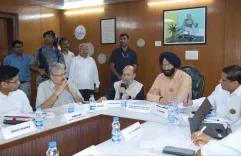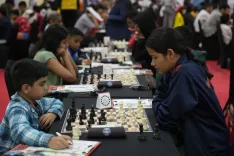Is DRDO Technology a Game Changer in Disaster Response?

Synopsis
Key Takeaways
- DRDO's technology is a force multiplier in disaster management.
- Proactive and integrated approach aims for zero casualties.
- Utilization of drones for surveillance and supply delivery.
- AI and Machine Learning enhance predictive analytics.
- IoT improves monitoring of responders and victims.
New Delhi, June 17 (NationPress) The Director General of the Defence Research and Development Organisation (DRDO), Dr Chandrika Kaushik, emphasized on Tuesday that technology acts as a significant force multiplier in the nation's commitment to a 'zero casualty' strategy in disaster management, which has gained international acclaim.
During the Annual Conference of Relief Commissioners and Disaster Response Forces, Dr Kaushik stated, “At DRDO, we are dedicated to developing systems and technologies that empower not only our forces but also assist other agencies within the Ministry of Home Affairs and communities to prepare, respond, and recover from disasters more efficiently.”
“Today, technology serves as our strongest ally in disaster management preparedness. Drones are extensively utilized for aerial surveillance and damage assessments, and even for delivering essential supplies to remote areas,” explained the DRDO DG (Production Coordination and Services Interaction).
Dr Kaushik highlighted that Artificial Intelligence and Machine Learning play a crucial role in predicting disaster patterns, rapidly analyzing satellite images, and monitoring social media in real-time for situational awareness.
Commenting on a co-speaker’s presentation regarding an App for predicting lightning, she noted, 'We have developed a similar App for predicting avalanches, which is essential for the armed forces operating in glacial regions.'
She added, 'If needed, this technology can be shared with various state agencies to enhance disaster warnings for the public.'
'The Internet of Things (IoT), equipped with real-time sensors, is crucial for monitoring the well-being of responders and victims during disasters,' she mentioned, underlining the growing role of robotics in search and rescue missions and geospatial technologies in evacuation efforts.
Discussing the importance of uninterrupted connectivity via satellites, she stated, 'The integrated use of these technologies is significantly improving our ability to respond to disasters in real-time.'
Over the years, she noted, the country’s approach to disaster response has evolved from being relief-oriented to becoming 'proactive, integrated, and outcome-focused,' with a national aim of achieving zero casualties.
On Monday, Union Home Minister Amit Shah praised the introduction of the Integrated Control Room for Emergency Response (ICR-ER), the National Database for Emergency Management Lite 2.0 (NDEM Lite 2.0), and the Flood Hazard Zonation Atlas of Assam.
In a post on X, he mentioned, 'These innovations will empower our disaster management framework with the speed and precision of modern technologies.'
The ICR-ER will enable real-time disaster responses nationwide by streaming satellite information to rescue teams, while NDEM Lite 2.0 will ensure our response units across the country can tackle any calamity cohesively, he explained.
'The Assam Atlas will provide essential data regarding floods, their impacts, and water levels in rivers to aid flood control authorities in achieving effective mitigation,' HM Shah concluded.






